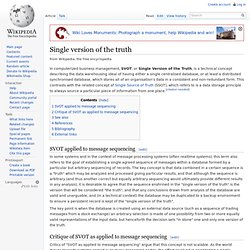

(2) Document Management Systems (DMS): What are the differences between a Document Management System and Enterprise Content Management? Need to Read - Automated Metadata. Top 10 criterias for ecm wp 1939579. File manager. Directory editors[edit] A term that predates the usage of file manager is directory editor.

The first directory editor, DIRED, was invented circa 1974 at the Stanford Artificial Intelligence Lab by Stan Kugell[1][2] A directory editor was written for EXEC 8 at the University of Maryland, and was available to other users at that time. The term was used by other developers, including Jay Lepreau, who wrote the dired program in 1980, [3] which ran on BSD. This was in turn inspired by an older program with the same name running on TOPS-20. File-list file manager[edit] File-list file managers are lesser known and older than orthodox file managers. One such file manager is flist, which was first used in 1981 on the Conversational Monitor System.[5][6] This is a variant of fulist, which originated before late 1978, according to comments by its author, Theo Alkema.[7] The flist program provided a list of files in the user's minidisk,[8] and allowed sorting by any file attribute.
Enterprise Content Management System Review 2014. Electronic discovery. Data are identified as potentially relevant by attorneys and placed on legal hold.

Evidence is then extracted and analyzed using digital forensic procedures, and is reviewed using a document review platform. Documents can be reviewed either as native files or after a conversion to PDF or TIFF form.[1] A document review platform is useful for its ability to aggregate and search large quantities of ESI. Electronic information is considered different from paper information because of its intangible form, volume, transience and persistence. Electronic information is usually accompanied by metadata that is not found in paper documents and that can play an important part as evidence (for example the date and time a document was written could be useful in a copyright case).
The preservation of metadata from electronic documents creates special challenges to prevent spoliation. Individuals working in the field of electronic discovery commonly refer to the field as Litigation Support.[3] Don't repeat yourself. Applying DRY[edit] DRY vs WET solutions[edit] Violations of DRY are typically referred to as WET solutions, which is commonly taken to stand for either "write everything twice" or "we enjoy typing".[2][3]
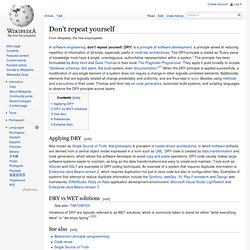
Document clustering. Overview[edit] Document clustering involves the use of descriptors and descriptor extraction.
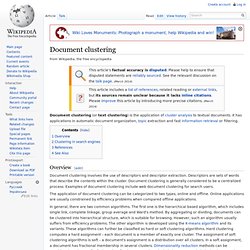
Descriptors are sets of words that describe the contents within the cluster. Document clustering is generally considered to be a centralized process. Examples of document clustering include web document clustering for search users. The application of document clustering can be categorized to two types, online and offline. In general, there are two common algorithms. Other algorithms involve graph based clustering, ontology supported clustering and order sensitive clustering. Given a clustering, it can be beneficial to automatically derive human-readable labels for the clusters. Clustering in search engines[edit] A web search engine often returns thousands of pages in response to a broad query, making it difficult for users to browse or to identify relevant information.
Examples: Clustering divides the results of a search for "cell" into groups like "biology," "battery," and "prison. " Publications: Metadata discovery. In metadata, metadata discovery is the process of using automated tools to discover the semantics of a data element in data sets.
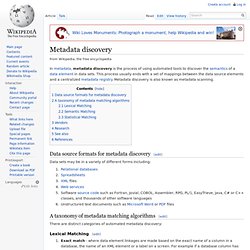
This process usually ends with a set of mappings between the data source elements and a centralized metadata registry. Metadata discovery is also known as metadata scanning. Single Source of Truth. In Information Systems design and theory Single Source Of Truth (SSOT) refers to the practice of structuring information models and associated schemata such that every data element is stored exactly once (e.g., in no more than a single row of a single table).
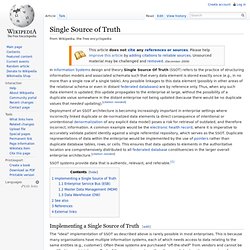
Any possible linkages to this data element (possibly in other areas of the relational schema or even in distant federated databases) are by reference only. Thus, when any such data element is updated, this update propagates to the enterprise at large, without the possibility of a duplicate value somewhere in the distant enterprise not being updated (because there would be no duplicate values that needed updating). [citation needed] SSOT systems provide data that is authentic, relevant, and referable.[1] Single version of the truth. In computerized business management, SVOT, or Single Version of the Truth, is a technical concept describing the data warehousing ideal of having either a single centralised database, or at least a distributed synchronised database, which stores all of an organisation's data in a consistent and non-redundant form.
